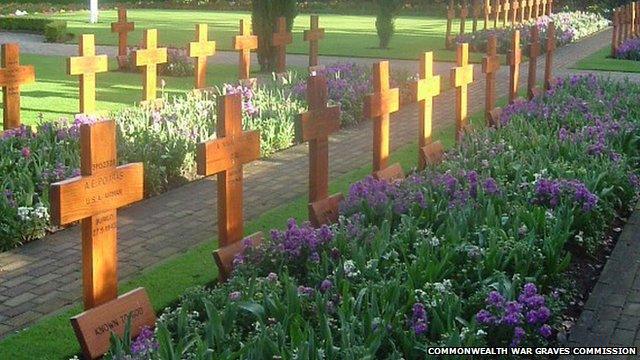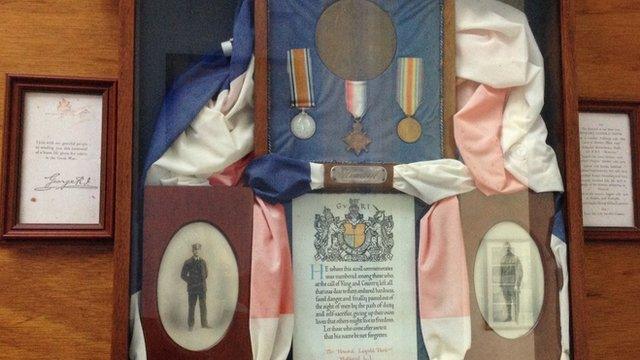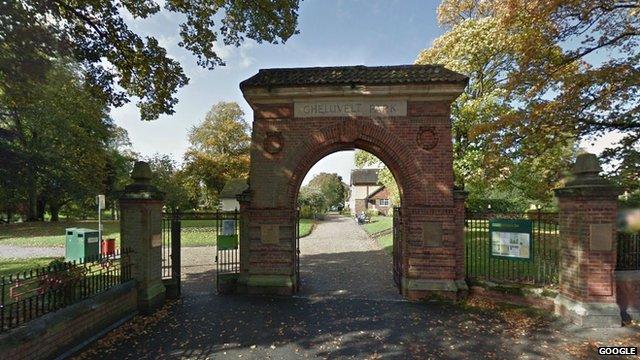World War One: Howard Davis Park bought as tribute to dead son
- Published

The oak crosses in the Commonwealth War Cemetery in Howard Davis park, Jersey
In a war cemetery in Jersey the graves are marked by wooden crosses rather than the distinctive white headstones seen in so many others. The cemetery is in a park bought by a locally-born businessman whose son died in the Battle of the Somme. Local legend has it that founding the park also allowed him to settle a grudge dating back to his childhood.
The Commonwealth War Graves Commission (CWGC) look after the graves and memorials of almost 1.7m Commonwealth servicemen and women who died in the two World Wars and are buried outside the UK.
The largest is at Tyne Cot, outside Ypres in Belgium, holding almost 12,000 graves - the smallest is the Ocracoke Island (British) Cemetery in North Carolina with only four burials.
The immaculately maintained cemeteries all contain the distinctive white headstones marking the graves.
But, in the St Helier War Cemetery, in Howard Davis Park, Jersey, the 41 graves are marked with wooden crosses.
"Each grave was marked by an oak cross, specially cut by Jersey craftsmen, from an oak tree presented by a local lady who had also lost a son in the First World War," Peter Francis, from the CWGC explained.
After WW2 the commission planned to replace the crosses with their usual white headstones, he added, but a campaign by local people changed its mind.
Only one of the crosses marks the grave of a soldier from WW1 - Pte George Hanlon, from Sandown on the Isle of Wight.
He was ruled unfit for active service when he joined up, and was sent to Jersey to guard prisoners of war.
He died of pleurisy in November 1916, but is still remembered.
Park staff recently found a note on his cross from a great great granddaughter saying simply: "Found you at last great great granddad."
Howard Davis Park itself is a memorial to a soldier killed in WW1, named after the son of a Jersey man who made his fortune in South Africa.
Thomas Benjamin Davis - always known as TB Davis - was born on the island in 1867, the son of a fisherman.

The old billiard room of the demolished mansion now contains Howard Davis' war medals
He went to sea at the age of fifteen, quickly rising to become a captain, and made his money running the loading and unloading of ships in ports across Africa.
His son Howard also went to sea, becoming a deck officer, but according to Doug Ford, community learning director at Jersey Heritage, was swept up in the rush to join the army in 1914.
"In 1914, he happened to be on a voyage to Europe and they docked in Glasgow on the outbreak of war.
"It's said that he met up with some ex-school friends and in that fit of jingoism that was very common in August 1914 they went to the nearest recruiting office, which happened to be the Highland Light Infantry and he joined as a Private.
"It was typical of the time, this patriotic rush to join the colours because everybody thought the war would be over by Christmas and they didn't want to miss the excitement."
Howard Davis went over the top on the first day of the Battle of The Somme.
"[He was] badly wounded, and taken back to a dressing station [and] eventually died of his wounds about six weeks later," said Mr Ford.
In 1937, a large mansion called Plaisance and its 10 acres of grounds on Jersey came up for sale.
Mr Davis Snr bought the estate, knocked the mansion down, and turned the land into a park named in memory of his son.
Local legend has it that as a child he had been caught looking for conkers in the grounds, was punished by the mansion's owner, and had sworn to one day buy the building and knock it down.
Whatever the truth of this, only the billiard room remains, which now contains Howard Davis' medals and family portraits.
The park was gifted to the island by Mr Davis Snr in September 1939, and is one of a number of parks set up to remember those who died in WW1.

Gheluvelt Park in Worcester was built with a row of homes for former soldiers inside
Others can be found around the UK:
Sheffield Memorial Park, external on the Somme battleground was opened in 1936 and preserves the trenches from which the locally-raised 'Pals Battalions' set off on the first day of the battle. It now contains memorials to the Sheffield City Battalion, the Accrington Pals, the Barnsley Pals and units from Chorley and Burnley.
Coventry War Memorial Park, external opened in 1921 on 49 hectares of land bought by the council. The war memorial commemorating the 2,587 Coventrians who died in WW1 was opened in 1927.
Basingstoke War Memorial Park, external - 16 acres of land known as Goldings Park was bought by public subscription in 1921. The war memorial was unveiled in 1927.
Fleetwood Memorial Park, external, Lancashire, was built on some former pleasure gardens, bought with funds raised by a committee of the district council. The park opened in 1926, and the war memorial was unveiled the following year. The park is now a Grade II listed monument.
War Memorial Park, Romsey, external was built on land called Street Mead, donated to the local council in middle ages. The park opened in 1920, and the war memorial was unveiled a year later. There are plans for a statue in the park to commemorate the 120,000 horses who passed through the Romsey Remount Depot.
Marple Memorial Park, Stockport, external was built on land donated by two local families who had lost sons. 10,000 people turned out for the official opening in 1922.
Forster Memorial Park, Lewisham, external was created on land given by Lord Forster in memory of his two sons John and Alfred. It was opened by his daughter in 1922.
Wyndham Memorial Park, Grantham, external was opened in 1924 on what had been the town's Slate Mill Par. Lady Leconfield donated £1000 towards a memorial to her son, Lt. Hon. William Reginald Wyndham, who was killed in November 1914.
Gheluvelt Park, Worcester, external is named after a battle fought by soldiers of the Worcestershire Regiment in October 1914. The park was opened in 1922 and has a row of bungalows for retired soldiers to live in.